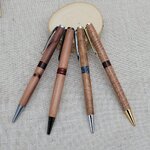Woodchipper
Member
I recently made two pens for a local charity's silent auction. Both turned out nice, IMO, but the Slimline lower blank was a bit proud of the center band. Didn't measure it! Duh! I turn down with the roughing gouge to close dimensions. Anyway, I have experimented with turning the ends of a blank by using the toe of a skew, taking very light cuts and measuring frequently. Anyone else have a technique for precision turning pen blanks?

